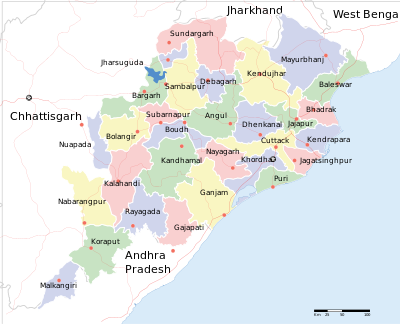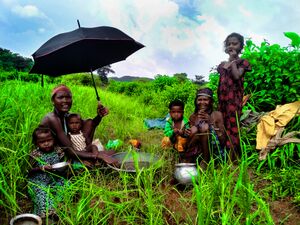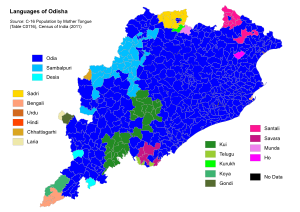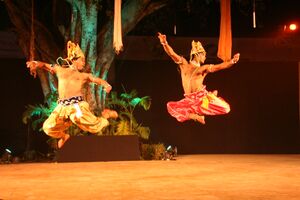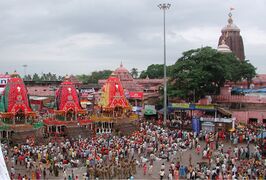أوديشا
أوديشا (بالإنگليزية: Orissa ؛ /əˈdɪsə/ [ك],[12] أوديا: [oɽiˈsaː] (![]() استمع))، سابقاً أوريسا (Orissa ؛ /ɒˈrɪsə, ɔː-, oʊ-/[13])، ولاية تقع في الساحل الشمالي الشرقي للهند، ومساحتها 155,707 كم²، وعدد سكانها 41,974,218 نسمة، وعاصمتها بوبانيشوَر. وهي من أقل الولايات الهندية كثافة في السكان. وهي ثامن أكبر ولاية من حيث المساحة، و الولاية الحادية عشر من حيث التعداد. وتضم الولاية ثالث أكبر تعداد للقبائل المجدولة في الهند.[14] وتحد أوديشا ولايات West Bengal and Jharkhand to the north, Chhattisgarh to the west, and Andhra Pradesh to the south. Odisha has a coastline of 485 كيلومتر (301 mi) along the Bay of Bengal.[15] The region is also known as Utkala and is mentioned in India's national anthem, "Jana Gana Mana".[16] The language of Odisha is Odia, which is one of the Classical Languages of India.[17]
استمع))، سابقاً أوريسا (Orissa ؛ /ɒˈrɪsə, ɔː-, oʊ-/[13])، ولاية تقع في الساحل الشمالي الشرقي للهند، ومساحتها 155,707 كم²، وعدد سكانها 41,974,218 نسمة، وعاصمتها بوبانيشوَر. وهي من أقل الولايات الهندية كثافة في السكان. وهي ثامن أكبر ولاية من حيث المساحة، و الولاية الحادية عشر من حيث التعداد. وتضم الولاية ثالث أكبر تعداد للقبائل المجدولة في الهند.[14] وتحد أوديشا ولايات West Bengal and Jharkhand to the north, Chhattisgarh to the west, and Andhra Pradesh to the south. Odisha has a coastline of 485 كيلومتر (301 mi) along the Bay of Bengal.[15] The region is also known as Utkala and is mentioned in India's national anthem, "Jana Gana Mana".[16] The language of Odisha is Odia, which is one of the Classical Languages of India.[17]
The ancient kingdom of Kalinga, which was invaded by the Mauryan emperor Ashoka (which was again won back from them by king Kharavela) in 261 BCE resulting in the Kalinga War, coincides with the borders of modern-day Odisha.[18] The modern boundaries of Odisha were demarcated by the British Indian government when Orissa Province was established on 1 April 1936, consisting of the Odia-speaking districts of Bihar and Orissa Province.[18] The first of April is celebrated as Utkala Dibasa.[19] Cuttack was made the capital of the region by Anantavarman Chodaganga in c. 1135,[20] after which the city was used as the capital by many rulers, through the British era until 1948. Thereafter, Bhubaneswar became the capital of Odisha.[21]
The economy of Odisha is the 16th-largest state economy in India with ₹5٫33 lakh crore (67 بليون US$) in gross domestic product and a per capita GDP of ₹116٬614 (US$1٬500).[3] Odisha ranks 32nd among Indian states in human development index.[22] وتعتمد في اقتصادها على الزراعة التقليدية كزراعة الأرز والدخن وصناعة الألومنيوم والأسمدة وصناعة النسيج وتعدين الحديد والبوكسيت والفحم الحجري.
التاريخ

Prehistoric Acheulian tools dating to Lower Paleolithic era have been discovered in various places in the region, implying an early settlement by humans.[23] Kalinga has been mentioned in ancient texts like Mahabharata, Vayu Purana and Mahagovinda Suttanta.[24][25] The Sabar people of Odisha have also been mentioned in the Mahabharata.[26][27] Baudhayana mentions Kalinga as not yet being influenced by Vedic traditions, implying it followed mostly tribal traditions.[28]
Ashoka of the Mauryan dynasty conquered Kalinga in the bloody Kalinga War in 261 BCE,[29] which was the eighth year of his reign.[30] According to his own edicts, in that war about 100,000 people were killed, 150,000 were captured and more were affected.[29] The resulting bloodshed and suffering of the war is said to have deeply affected Ashoka. He turned into a pacifist and converted to Buddhism.[30][31]
في حوالي 150 ق.م.، الامبراطور خراڤلا، الذي ربما عاصر دمتريوس الأول من باكتريا،[32] أخضع جزءاً كبيراً من شبه القارة الهندية. وقد كان خراڤلا يعتنق الجاينية. وشيّد ديراً على قمة ربوة Udayagiri.[33] Subsequently, the region was ruled by monarchs, such as Samudragupta[34] and Shashanka.[35] It was also a part of Harsha's empire.[36]
The city of Brahmapur in Odisha is also known to have been the capital of the Pauravas during the closing years of 4th Century CE. Nothing was heard from the Pauravas from about the 3rd Century CE, because they were annexed by the Yaudheya Republic, who in turn submitted to the Mauryans. It was only at the end of 4th century CE, that they established royalty at Brahmapur, after about 700 years.
Later, the kings of the Somavamsi dynasty began to unite the region. By the reign of Yayati II, c. 1025 CE, they had integrated the region into a single kingdom. Yayati II is supposed to have built the Lingaraj temple at Bhubaneswar.[18] They were replaced by the Eastern Ganga dynasty. Notable rulers of the dynasty were Anantavarman Chodaganga, who began re-construction on the present-day Shri Jagannath Temple in Puri (c. 1135), and Narasimhadeva I, who constructed the Konark temple (c. 1250).[37][38]
The Eastern Ganga Dynasty was followed by the Gajapati Kingdom. The region resisted integration into the Mughal empire until 1568, when it was conquered by Sultanate of Bengal.[39] Mukunda Deva, who is considered the last independent king of Kalinga, was defeated and was killed in battle by a rebel Ramachandra Bhanja. Ramachandra Bhanja himself was killed by Bayazid Khan Karrani.[40] In 1591, Man Singh I, then governor of Bihar, led an army to take Odisha from the Karranis of Bengal. They agreed to treaty because their leader Qutlu Khan Lohani had recently died. But, they then broke the treaty by attacking the temple town of Puri. Man Singh returned in 1592 and pacified the region.[41]
In 1751, the Nawab of Bengal Alivardi Khan ceded the region to the Maratha Empire.[18]
The British had occupied the Northern Circars, comprising the southern coast of Odisha, as a result of the Second Carnatic War by 1760, and incorporated them into the Madras Presidency gradually.[42] In 1803, the British ousted the Marathas from the Puri-Cuttack region of Odisha during the Second Anglo-Maratha War. The northern and western districts of Odisha were incorporated into the Bengal Presidency.[43]
The Orissa famine of 1866 caused an estimated 1 million deaths.[44] Following this, large-scale irrigation projects were undertaken.[45] In 1903, the Utkal Sammilani organisation was founded to demand the unification of Odia-speaking regions into one state.[46] On 1 April 1912, the Bihar and Orissa Province was formed.[47] On 1 April 1936, Bihar and Orissa were split into separate provinces.[48] The new province of Orissa came into existence on a linguistic basis during the British rule in India, with Sir John Austen Hubback as the first governor.[48][49] Following India's independence, on 15 August 1947, 27 princely states signed the document to join Orissa.[50] Most of the Orissa Tributary States, a group of princely states, acceded to Orissa in 1948, after the collapse of the Eastern States Union.[51]
الجغرافيا
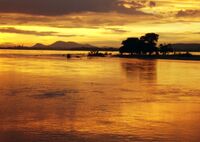
Odisha lies between the latitudes 17.780N and 22.730N, and between longitudes 81.37E and 87.53E. The state has an area of 155,707 km2, which is 4.87% of total area of India, and a coastline of 450 km.[52] In the eastern part of the state lies the coastal plain. It extends from the Subarnarekha River in the north to the Rushikulya river in the south. The lake Chilika is part of the coastal plains. The plains are rich in fertile silt deposited by the six major rivers flowing into the Bay of Bengal: Subarnarekha, Budhabalanga, Baitarani, Brahmani, مهانادي and Rushikulya.[52] The Central Rice Research Institute (CRRI), a Food and Agriculture Organization-recognised rice gene bank and research institute, is situated on the banks of Mahanadi in Cuttack.[53] The stretch between Puri and Bhadrak in Odisha juts out a little into the sea, making it vulnerable to any cyclonic activity.[54]
Three-quarters of the state is covered in mountain ranges. Deep and broad valleys have been made in them by rivers. These valleys have fertile soil and are densely populated. Odisha also has plateaus and rolling uplands, which have lower elevation than the plateaus.[52] The highest point in the state is Deomali at 1,672 metres. The other high peaks are: Sinkaram (1,620 m), Golikoda (1,617 m), and Yendrika (1,582 metres).[55]
المناخ
The state experiences four meteorological seasons: الشتاء (January to February), pre-monsoon season (March to May), south-west monsoon season (June to September) and north east monsoon season (October–December). However, locally the year is divided into six traditional seasons (or rutus): Grishma (summer), Barsha (rainy season), Sharata (autumn), Hemanta (dewy),Sheeta(winter season) and Basanta (spring).[52]
| Mean Temp and Precipitation of Selected Weather Stations[56] | ||||||||||||
|---|---|---|---|---|---|---|---|---|---|---|---|---|
| بوبانيشوَر (1952–2000) |
Balasore (1901–2000) |
Gopalpur (1901–2000) |
Sambalpur (1901–2000) | |||||||||
| Max (C) | Min (C) | Rainfall (mm) | Max (C) | Min (C) | Rainfall (mm) | Max (C) | Min (C) | Rainfall (mm) | Max (C) | Min (C) | Rainfall (mm) | |
| January | 28.5 | 15.5 | 13.1 | 27.0 | 13.9 | 17.0 | 27.2 | 16.9 | 11.0 | 27.6 | 12.6 | 14.2 |
| February | 31.6 | 18.6 | 25.5 | 29.5 | 16.7 | 36.3 | 28.9 | 19.5 | 23.6 | 30.1 | 15.1 | 28.0 |
| March | 35.1 | 22.3 | 25.2 | 33.7 | 21.0 | 39.4 | 30.7 | 22.6 | 18.1 | 35.0 | 19.0 | 20.9 |
| April | 37.2 | 25.1 | 30.8 | 36.0 | 24.4 | 54.8 | 31.2 | 25.0 | 20.3 | 39.3 | 23.5 | 14.2 |
| May | 37.5 | 26.5 | 68.2 | 36.1 | 26.0 | 108.6 | 32.4 | 26.7 | 53.8 | 41.4 | 27.0 | 22.7 |
| June | 35.2 | 26.1 | 204.9 | 34.2 | 26.2 | 233.4 | 32.3 | 26.8 | 138.1 | 36.9 | 26.7 | 218.9 |
| July | 32.0 | 25.2 | 326.2 | 31.8 | 25.8 | 297.9 | 31.0 | 26.1 | 174.6 | 31.1 | 24.9 | 459.0 |
| August | 31.6 | 25.1 | 366.8 | 31.4 | 25.8 | 318.3 | 31.2 | 25.9 | 195.9 | 30.7 | 24.8 | 487.5 |
| September | 31.9 | 24.8 | 256.3 | 31.7 | 25.5 | 275.8 | 31.7 | 25.7 | 192.0 | 31.7 | 24.6 | 243.5 |
| October | 31.7 | 23.0 | 190.7 | 31.3 | 23.0 | 184.0 | 31.4 | 23.8 | 237.8 | 31.7 | 21.8 | 56.6 |
| November | 30.2 | 18.8 | 41.7 | 29.2 | 17.8 | 41.6 | 29.5 | 19.7 | 95.3 | 29.4 | 16.2 | 17.6 |
| December | 28.3 | 15.2 | 4.9 | 26.9 | 13.7 | 6.5 | 27.4 | 16.4 | 11.4 | 27.2 | 12.1 | 4.8 |
التنوع الحيوي
Satapada is situated close to the northeast cape of Chilika Lake and Bay of Bengal. It is famous for dolphin watching in their natural habitat. There is a tiny island en route for watching dolphins, where tourists often take a short stop. Apart from that, this island is also home for tiny red crabs.
According to a census conducted in 2016, there are around 2000 elephants in the state. [57]
White tiger in the Nandankanan Zoo
Irrawaddy dolphins can be found in Chilika
Vanda tessellata, one of the orchids found in Odisha[58]
Birds at Chilika Lake
Crocodile in Bhitarkanika National Park
التقسيمات
Odisha has been divided into 30 districts. These 30 districts have been placed under three different revenue divisions to streamline their governance. The divisions are North, Central and South, with their headquarters at Sambalpur, Cuttack and Berhampur respectively. Each division consists of ten districts and has as its administrative head a Revenue Divisional Commissioner (RDC).[59] The position of the RDC in the administrative hierarchy is that between that of the district administration and the state secretariat.[60] The RDCs report to the Board of Revenue, which is headed by a senior officer of the Indian Administrative Service.[59]
| القسم الشمالي (HQ – سمبلپور) | القسم الأوسط (HQ – كتك) | القسم الجنوبي (HQ – Berhampur) |
|---|---|---|
البلديات الأخرى في أوديشا تضم Angul, Balangir, Balasore, Barbil, Bargarh, Baripada, Belpahar, Bhadrak, Bhawanipatna, Biramitrapur, Boudh, Brajarajnagar, Byasanagar, Chhatrapur, Deogarh, Dhenkanal, Gopalpur, Gunupur, Hinjilicut, Jagatsinghpur, Jajpur, Jeypore, Jharsuguda, Joda, Kendrapara, Kendujhar, Khordha, Konark, Koraput, Malkangiri, Nabarangpur, Nayagarh, Nuapada, Paradeep, Paralakhemundi, Phulbani, Puri, Rajgangpur, Rayagada, Sonepur, Sundargarh, Talcher, Titilagarh and Umerkote.
| Rank | الضلع | Pop. | |||||||
|---|---|---|---|---|---|---|---|---|---|
 بوبانيشوَر  كتك |
1 | بوبانيشوَر | خوردا | 881,988 |  روركلا  براهماپور | ||||
| 2 | كتك | كتك | 658,986 | ||||||
| 3 | روركلا | سوندرگره | 552,970 | ||||||
| 4 | براهماپور | گنجام | 355,823 | ||||||
| 5 | سمبلپور | سمبلپور | 270,331 | ||||||
| 6 | پوري | پوري | 201,026 | ||||||
| 7 | بالاسور | بالاسور | 144,373 | ||||||
| 8 | Bhadrak | Bhadrak | 121,338 | ||||||
| 9 | Baripada | Mayurbhanj | 116,874 | ||||||
| 10 | Balangir | Balangir | 98,238 | ||||||
Auxiliary authorities known as panchayats, for which local body elections are regularly held, govern local affairs in rural areas.
الديمغرافيا
| السنة | تعداد | ±% p.a. |
|---|---|---|
| 1901 | 10٬302٬917 | — |
| 1911 | 11٬378٬875 | +1.00% |
| 1921 | 11٬158٬586 | −0.20% |
| 1931 | 12٬491٬056 | +1.13% |
| 1941 | 13٬767٬988 | +0.98% |
| 1951 | 14٬645٬946 | +0.62% |
| 1961 | 17٬548٬846 | +1.82% |
| 1971 | 21٬944٬615 | +2.26% |
| 1981 | 26٬370٬271 | +1.85% |
| 1991 | 31٬659٬736 | +1.84% |
| 2001 | 36٬804٬660 | +1.52% |
| 2011 | 41٬974٬218 | +1.32% |
| source:[62] | ||
According to the 2011 census of India, the total population of Odisha is 41,974,218, of which 21,212,136 (50.54%) are male and 20,762,082 (49.46%) are female, or 978 females per 1000 males. This represents a 13.97% increase over the population in 2001. The population density is 270 per km2.[2]
The literacy rate is 73%, with 82% of males and 64% of females being literate, according to the 2011 census.
The proportion of people living below the poverty line in 2004–2005 was 57.15% which was nearly double the Indian average of 26.10%. Since 2005 the state has reduced poverty rate dramatically by 24.6 percentage points. According to current estimate proportion of people living under poverty line was 32.6%[63][64]
Data of 1996–2001 showed the life expectancy in the state was 61.64 years, higher than the national value of years. The state has a birth rate of 23.2 per 1,000 people per year, a death rate of 9.1 per 1,000 people per year, an infant mortality rate of 65 per 1000 live birth and a maternal mortality rate of 358 per 1,000,000 live births. Odisha has a Human Development Index of 0.606 as of 2018.[65]
| الضلع | المقر | التعداد (2011) |
ذكور | إناث | النسبة النمو العشري 2001–2011 |
نسبة الجنسين | كثافة (شخص في كم²) |
تعداد الأطفال 0–6 سنة |
نسبة جنس الطفل |
معدل اللاأمية | |
|---|---|---|---|---|---|---|---|---|---|---|---|
| 1 | أنگول | أنگول | 1٬271٬703 | 654٬898 | 616٬805 | 11٫55 | 942 | 199 | 145٬690 | 884 | 78٫96 |
| 2 | Balangir | Balangir | 1٬648٬574 | 831٬349 | 817٬225 | 23٫29 | 983 | 251 | 206٬964 | 951 | 65٫50 |
| 3 | Balasore | Baleswar | 2٬317٬419 | 1٬184٬371 | 1٬133٬048 | 14٫47 | 957 | 609 | 274٬432 | 941 | 80٫66 |
| 4 | Bargarh | Bargarh | 1٬478٬833 | 748٬332 | 730٬501 | 9٫84 | 976 | 253 | 156٬185 | 946 | 75٫16 |
| 5 | Bhadrak | Bhadrak | 1٬506٬522 | 760٬591 | 745٬931 | 12٫95 | 981 | 601 | 176٬793 | 931 | 83٫25 |
| 6 | Boudh | Boudh | 439٬917 | 220٬993 | 218٬924 | 17٫82 | 991 | 142 | 59٬094 | 975 | 72٫51 |
| 7 | Cuttack | Cuttack | 2٬618٬708 | 1٬339٬153 | 1٬279٬555 | 11٫87 | 955 | 666 | 251٬152 | 913 | 84٫20 |
| 8 | Debagarh | Debagarh | 312٬164 | 158٬017 | 154٬147 | 13٫88 | 976 | 106 | 38٬621 | 917 | 73٫07 |
| 9 | Dhenkanal | Dhenkanal | 1٬192٬948 | 612٬597 | 580٬351 | 11٫82 | 947 | 268 | 132٬647 | 870 | 79٫41 |
| 10 | Gajapati | Paralakhemundi | 575٬880 | 282٬041 | 293٬839 | 10٫99 | 1٬042 | 133 | 82٬777 | 964 | 54٫29 |
| 11 | Ganjam | Chhatrapur | 3٬520٬151 | 1٬777٬324 | 1٬742٬827 | 11٫37 | 981 | 429 | 397٬920 | 899 | 71٫88 |
| 12 | Jagatsinghpur | Jagatsinghpur | 1٬136٬604 | 577٬699 | 558٬905 | 7٫44 | 967 | 681 | 103٬517 | 929 | 87٫13 |
| 13 | Jajpur | Jajpur | 1٬826٬275 | 926٬058 | 900٬217 | 12٫43 | 972 | 630 | 207٬310 | 921 | 80٫44 |
| 14 | Jharsuguda | Jharsuguda | 579٬499 | 297٬014 | 282٬485 | 12٫56 | 951 | 274 | 61٬823 | 938 | 78٫36 |
| 15 | Kalahandi | Bhawanipatna | 1٬573٬054 | 785٬179 | 787٬875 | 17٫79 | 1٬003 | 199 | 214٬111 | 947 | 60٫22 |
| 16 | Kandhamal | Phulbani | 731٬952 | 359٬401 | 372٬551 | 12٫92 | 1٬037 | 91 | 106٬379 | 960 | 65٫12 |
| 17 | Kendrapara | Kendrapara | 1٬439٬891 | 717٬695 | 722٬196 | 10٫59 | 1٬006 | 545 | 153٬443 | 921 | 85٫93 |
| 18 | Kendujhar | Kendujhar | 1٬802٬777 | 907٬135 | 895٬642 | 15٫42 | 987 | 217 | 253٬418 | 957 | 69٫00 |
| 19 | خوردا | خوردا | 2٬246٬341 | 1٬166٬949 | 1٬079٬392 | 19٫65 | 925 | 799 | 222٬275 | 910 | 87٫51 |
| 20 | كوراپوت | كوراپوت | 1٬376٬934 | 677٬864 | 699٬070 | 16٫63 | 1٬031 | 156 | 215٬518 | 970 | 49٫87 |
| 21 | Malkangiri | Malkangiri | 612٬727 | 303٬913 | 308٬814 | 21٫53 | 1٬016 | 106 | 105٬636 | 979 | 49٫49 |
| 22 | Mayurbhanj | Baripada | 2٬513٬895 | 1٬253٬633 | 1٬260٬262 | 13٫06 | 1٬005 | 241 | 337٬757 | 952 | 63٫98 |
| 23 | Nabarangapur | Nabarangpur | 1٬218٬762 | 604٬046 | 614٬716 | 18٫81 | 1٬018 | 230 | 201٬901 | 988 | 48٫20 |
| 24 | Nayagarh | Nayagarh | 962٬215 | 502٬194 | 460٬021 | 11٫30 | 916 | 247 | 101٬337 | 851 | 79٫17 |
| 25 | Nuapada | Nuapada | 606٬490 | 300٬307 | 306٬183 | 14٫28 | 1٬020 | 157 | 84٬893 | 971 | 58٫20 |
| 26 | Puri | Puri | 1٬697٬983 | 865٬209 | 832٬774 | 13٫00 | 963 | 488 | 164٬388 | 924 | 85٫37 |
| 27 | Rayagada | Rayagada | 961٬959 | 469٬672 | 492٬287 | 15٫74 | 1٬048 | 136 | 141٬167 | 955 | 50٫88 |
| 28 | Sambalpur | Sambalpur | 1٬044٬410 | 529٬424 | 514٬986 | 12٫24 | 973 | 158 | 112٬946 | 931 | 76٫91 |
| 29 | Subarnapur | Sonepur | 652٬107 | 332٬897 | 319٬210 | 20٫35 | 959 | 279 | 76٬536 | 947 | 74٫42 |
| 30 | Sundergarh | Sundergarh | 2٬080٬664 | 1٬055٬723 | 1٬024٬941 | 13٫66 | 971 | 214 | 249٬020 | 937 | 74٫13 |
الدين
The majority (almost 94%[67]) of people in Odisha are Hindu and there is also a rich cultural heritage in the state. For example, Odisha is home to several Hindu figures. Sant Bhima Bhoi was a leader of the Mahima sect. Sarala Das, a Hindu Khandayat, was the translator of the epic Mahabharata into Odia. Chaitanya Das was a Buddhistic-Vaishnava and writer of the Nirguna Mahatmya. Jayadeva was the author of the Gita Govinda.
The Odisha Temple Authorisation Act of 1948 empowered the government of Odisha to open temples for all Hindus, including Dalits.[68]
Perhaps the oldest scripture of Odisha is the Madala Panji from the Puri Temple believed from 1042 AD. Famous Hindu Odia scripture includes the 16th-century Bhagabata of Jagannatha Dasa.[69] In the modern times Madhusudan Rao was a major Odia writer, who was a Brahmo Samajist and shaped modern Odia literature at the start of the 20th century.[70]
Christians in Odisha are 2.8% of the population, mainly tribals and Dalits. Odia Muslims live in the urban areas of coastal Odisha. The Sikh, Buddhist, and Jain communities together account for 0.1% of the population.[67]
Evolution of religious identity
| Religion | 1951 | 1961 | 1971 | 1981 | 1991 | 2001 | 2011 | |||||||
|---|---|---|---|---|---|---|---|---|---|---|---|---|---|---|
| Population | % | Population | % | Population | % | Population | % | Population | % | Population | % | Population | % | |
| Hinduism | 14,368,411 | 98.11 | 17,123,194 | 97.57 | 21,121,056 | 96.25 | 25,161,725 | 95.42 | 29,971,257 | 94.67 | 34,726,129 | 94.35 | 39,300,341 | 93.63 |
| Islam | 176,338 | 1.20 | 215,319 | 1.23 | 326,507 | 1.49 | 422,266 | 1.60 | 577,775 | 1.82 | 761,985 | 2.07 | 911,670 | 2.17 |
| Christianity | 141,934 | 0.97 | 201,017 | 1.15 | 378,888 | 1.73 | 480,426 | 1.82 | 666,220 | 2.10 | 897,861 | 2.44 | 1,161,708 | 2.77 |
| Sikhism | 4,163 | 0.03 | 9,316 | 0.05 | 10,204 | 0.04 | 14,270 | 0.05 | 17,296 | 0.05 | 17,492 | 0.05 | 21,991 | 0.05 |
| Jainism | 1,248 | 0.01 | 6,521 | 0.03 | 6,642 | 0.03 | 6,302 | 0.02 | 9,154 | 0.02 | 9,420 | 0.02 | ||
| Buddhism | 969 | 0.01 | 8,462 | 0.04 | 8,028 | 0.03 | 9,153 | 0.03 | 9,863 | 0.03 | 13,852 | 0.03 | ||
| Other Religions and Persuasions | 2,883 | 0.02 | 91,859 | 0.42 | 273,596 | 1.04 | 397,798 | 1.26 | 361,981 | 0.98 | 478,317 | 1.14 | ||
| Not Stated | NA | NA | 1,118 | 0.01 | 3,318 | 0.01 | 13,935 | 0.04 | 20,195 | 0.05 | 76,919 | 0.18 | ||
| Total | 14,645,946 | 100 | 17,548,846 | 100 | 21,944,615 | 100 | 26,370,271 | 100 | 31,659,736 | 100 | 36,804,660 | 100 | 41,974,218 | 100 |
اللغات
Odia is the official language of Odisha[78] and is spoken by 82.70% of the population according to the 2011 census of India.[77] It is also one of the classical languages of India. English is the official language of correspondence between state and the union of India. Spoken Odia is not homogeneous as one can find different dialects spoken across the state. Some of the major dialects found inside the state are Sambalpuri, Cuttacki, Puri, Baleswari, Ganjami, Desiya, Kalahandia and Phulbani. The standard language is based on the Cuttacki dialect. In addition to Odia, significant populations of people speaking other major Indian languages like Hindi, Telugu, Urdu and Bengali are also found in the state, mainly in cities.[79]
The different tribal (Adivasi) communities who mostly reside in western and southern Odisha have their own languages belonging to Munda and Dravidian family of languages. Some of these major tribal languages are Santali, Kui, Mundari and Ho. Due to increasing contact with outsiders, migration and socioeconomic reasons many of these indigenous languages are slowly getting extinct or are on the verge of getting extinct.[80]
The Odisha Sahitya Academy Award was established in 1957 to actively develop Odia language and literature. The Odisha government launched a portal in 2018 to promote Odia language and literature.[81]
الثقافة
المطبخ
Odisha has a culinary tradition spanning centuries. The kitchen of the Shri Jagannath Temple, Puri is reputed to be the largest in the world, with 1,000 chefs, working around 752 wood-burning clay hearths called chulas, to feed over 10,000 people each day.[82][83]
The syrupy dessert Pahala rasagola made in Odisha is known throughout the world.[84] Chhenapoda is another major Odisha sweet cuisine, which originated in Nayagarh.[85] Dalma (a mix of dal and selected vegetables) is widely known cuisine, better served with ghee.[بحاجة لمصدر]
The "Odisha Rasagola" was awarded a GI tag 29 July 2019 after a long battle about the origin of the famous sweet with West Bengal.[86]
الرقص
Odissi dance and music are classical art forms. Odissi is the oldest surviving dance form in India on the basis of archaeological evidence.[87] Odissi has a long, unbroken tradition of 2,000 years, and finds mention in the Natyashastra of Bharatamuni, possibly written c. 200 BC. However, the dance form nearly became extinct during the British period, only to be revived after India's independence by a few gurus.
The variety of dances includes Ghumura dance, Chhau dance, Jhumair, Mahari dance, Dalkhai, Dhemsa and Gotipua.
الرياضة
The state of Odisha has hosted several international sporting events, including the 2018 Men's Hockey World Cup, 2022 FIFA U-17 Women's World Cup and 2023 Men's Hockey World Cup.
Sports stadiums in Odisha include:
- Kalinga Stadium
- Barabati Stadium
- Jawaharlal Nehru Indoor Stadium
- East Coast Railway Stadium
- Biju Patnaik Hockey Stadium
- KIIT Stadium
- Veer Surendra Sai Stadium
- Birsa Munda International Hockey Stadium[88]
There are some High Performance Centres in the state as well which have been set up at Kalinga Stadium for the development of respective sports in Odisha. Some of the HPCs are as follows:
- Abhinav Bindra Targeting Performance (ABTP)
- Dalmia Bharat Gopichand Badminton Academy
- JSW Swimming HPC
- Khelo India State Centre of Excellence (KISCE) for Athletics, Hockey, and Weightlifting
- KJS Ahluwalia and Tenvic Sports HPC for Weightlifting
- Odisha Naval Tata Hockey High Performance Centre (ONTHHPC) [89]
- Odisha Aditya Birla and Gagan Narang Shooting HPC
- Reliance Foundation Odisha Athletics HPC
- SAI Regional Badminton Academy[90]
- Udaan Badminton Academy[91]
- AIFF High Performance Centre[92]
السياحة
The Lingaraja Temple at Bhubaneswar has a 150-قدم (46 m) high deula while the Jagannath Temple, Puri is about 200 أقدام (61 m) high and dominates the skyline. Only a portion of the Konark Sun Temple at Konark in Puri district, the largest of the temples of the "Holy Golden Triangle" exists today, and it is still staggering in size. It stands out as a masterpiece in Odisha architecture. Sarala Temple, regarded as one of the most spiritually elevated expressions of Shaktism is in Jagatsinghpur district. It is also one of the holiest places in Odisha and a major tourist attraction. Maa Tarini Temple situated in Kendujhar district is also a famous pilgrimage destination. Every day thousands of coconuts are given to Maa Tarini by devotees for fulfilling their wishes.[93]
Odisha's varying topography – from the wooded Eastern Ghats to the fertile river basin – has proven ideal for evolution of compact and unique ecosystems. This creates treasure troves of flora and fauna that are inviting to many migratory species of birds and reptiles. Bhitarkanika National Park in Kendrapada district is famous for its second largest mangrove ecosystem. The bird sanctuary in Chilika Lake (Asia's largest brackish water lake). The tiger reserve and waterfalls in Simlipal National Park, Mayurbhanj district are integral parts of eco-tourism in Odisha, arranged by Odisha Tourism.[94]
Daringbadi is a hill station in the Kandhamal district. It is known as "Kashmir of Odisha", for its climatic similarity. Chandipur, in Baleswar district is a calm and serene site, is mostly unexplored by tourists. The unique speciality of this beach is the ebb tides that recede up to 4 km and tend to disappear rhythmically.
In the western part of Odisha, Hirakud Dam in Sambalpur district is the longest earthen dam in the World. It also forms the biggest artificial lake in Asia. The Debrigarh Wildlife Sanctuary is situated near Hirakud Dam. Samaleswari Temple is a Hindu temple in Sambalpur city, dedicated to the goddess known as 'Samaleswari', the presiding deity of Sambalpur, is a strong religious force in western part of Odisha and Chhattisgarh state. The Leaning Temple of Huma is located near Sambalpur. The temple is dedicated to the Hindu god Lord Bimaleshwar. Sri Sri Harishankar Devasthana, is a temple on the slopes of Gandhamardhan hills, Balangir district. It is popular for its scenes of nature and connection to two Hindu lords, Vishnu and Shiva. On the opposite side of the Gandhamardhan hills is the temple of Sri Nrusinghanath, is situated at the foothills of Gandhamardhan Hill near Paikmal, Bargarh district.
In the southern part of Odisha, The Taratarini Temple on the Kumari hills at the bank of the Rushikulya River near Berhampur city in Ganjam district. Here worshiped as the Breast Shrine (Sthana Peetha) and manifestations of Adi Shakti. The Tara Tarini Shakti Peetha is one of the oldest pilgrimage centers of the Mother Goddess and is one of four major ancient Tantra Peetha and Shakti Peethas in India. Deomali is a mountain peak of the Eastern Ghats. It is located in Koraput district. This peak with an elevation of about 1,672 m, is the highest peak in Odisha.
The share of foreign tourists' arrival in the state is below one per cent of total foreign tourist arrivals at all India level.[95]
The Rath Yatra in Jagannath Temple, Puri
Gundichaghagi waterfall Keonjhar during monsoons
انظر أيضاً
- Cinema of Odisha
- ثقافة أوديشا
- Festivals of Odisha
- Flora and fauna of Odisha
- List of Odia writers
- List of schools in Odisha
- أدب أوديا
- Odisha Government Schemes List
- Odissi music
المصادر
- ^ "Cities having population 1 lakh and above, Census 2011" (PDF). حكومة الهند. Archived (PDF) from the original on 25 November 2014. Retrieved 2 February 2015.
- ^ أ ب "Population, Size and Decadal Change" (PDF). Primary Census Abstract Data Highlights, Census of India. Registrar General and Census Commissioner of India. 2018. Archived (PDF) from the original on 2019-10-19. Retrieved 2020-06-16.
- ^ أ ب "Odisha Budget analysis". PRS India. 18 February 2020. Retrieved 27 September 2020.
- ^ "Sub-national HDI – Subnational HDI – Global Data Lab". globaldatalab.org. Retrieved 2020-04-17.
- ^ "State of Literacy" (PDF). Census of India. p. 110. Archived (PDF) from the original on 6 July 2015. Retrieved 5 August 2015.
- ^ "Report of the Commissioner for linguistic minorities: 47th report (July 2008 to June 2010)" (PDF). Commissioner for Linguistic Minorities, Ministry of Minority Affairs, Government of India. pp. 122–126. Archived from the original (PDF) on 13 May 2012. Retrieved 16 February 2012.
- ^ أ ب ت Blue Jay, Orissa Review, 2005, p. 87, http://magazines.odisha.gov.in/Orissareview/apr2005/englishpdf/bluelay.pdf
- ^ "Palapitta: How a mindless dasara ritual is killing our state bird palapitta – Hyderabad News". The Times of India. 29 September 2017. Retrieved 7 October 2019.
- ^ Blue Jay, Orissa Review, 2005, http://magazines.odisha.gov.in/Orissareview/apr2005/englishpdf/bluelay.pdf
- ^ "State Fishes of India" (PDF). National Fisheries Development Board, Government of India. Retrieved 25 December 2020.
- ^ Pipal(Ficus religiosa) – The State Tree of Odisha, RPRC, 2014, http://rprcbbsr.in/View/Downloads/Ficusreligiosa18_11_2014.pdf
- ^ قالب:Lexico
- ^ Jones, Daniel (2003) [1917]. Roach, Peter; Hartmann, James; Setter, Jane (eds.). English Pronouncing Dictionary. Cambridge: Cambridge University Press. ISBN 3-12-539683-2.
- ^ "ST & SC Development, Minorities & Backward Classes Welfare Department:: Government of Odisha". stscodisha.gov.in. Archived from the original on 1 September 2018. Retrieved 10 December 2018.
- ^ "Coastal security". Odisha Police. Archived from the original on 6 February 2015. Retrieved 1 February 2015.
- ^ "The National Anthem of India" (PDF). Columbia University. Archived (PDF) from the original on 24 January 2012. Retrieved 1 February 2015.
- ^ https://www.jagranjosh.com/current-affairs/cabinet-approved-odia-as-classical-language-1392954604-1
- ^ أ ب ت ث "Detail History of Orissa". Government of Odisha. Archived from the original on 12 November 2006.
- ^ "Utkala Dibasa hails colours, flavours of Odisha". The Times of India. 2 April 2014. Archived from the original on 8 July 2015. Retrieved 1 February 2015.
- ^ Rabindra Nath Chakraborty (1985). National Integration in Historical Perspective: A Cultural Regeneration in Eastern India. Mittal Publications. pp. 17–. GGKEY:CNFHULBK119. Archived from the original on 15 May 2013. Retrieved 30 November 2012.
- ^ Ravi Kalia (1994). Bhubaneswar: From a Temple Town to a Capital City. SIU Press. p. 23. ISBN 978-0-8093-1876-6. Archived from the original on 5 January 2016. Retrieved 2 February 2015.
- ^ "Sub-national HDI – Area Database". Global Data Lab. Institute for Management Research, Radboud University. Archived from the original on 23 September 2018. Retrieved 25 September 2018.
- ^ Amalananda Ghosh (1990). An Encyclopaedia of Indian Archaeology. BRILL. p. 24. ISBN 9004092641. Archived from the original on 5 January 2016. Retrieved 29 October 2012.
- ^ Subodh Kapoor, ed. (2004). An Introduction to Epic Philosophy: Epic Period, History, Literature, Pantheon, Philosophy, Traditions, and Mythology, Volume 3. Genesis Publishing. p. 784. ISBN 9788177558814. Archived from the original on 5 January 2016. Retrieved 10 November 2012.
Finally Srutayudha, a valiant hero, was son Varuna and of the river Parnasa.
- ^ Devendrakumar Rajaram Patil (1946). Cultural History from the Vāyu Purāna. Motilal Banarsidass Pub. p. 46. ISBN 9788120820852. Archived from the original on 5 January 2016. Retrieved 15 November 2015.
- ^ "Dance bow (1965.3.5)". Pitt Rivers Museum. Archived from the original on 2 February 2015. Retrieved 4 February 2015.
- ^ Rabindra Nath Pati (1 January 2008). Family Planning. APH Publishing. p. 97. ISBN 978-81-313-0352-8. Archived from the original on 5 January 2016. Retrieved 2 February 2015.
- ^ Suhas Chatterjee (1 January 1998). Indian Civilization And Culture. M.D. Publications Pvt. Ltd. p. 68. ISBN 978-81-7533-083-2. Archived from the original on 15 May 2013. Retrieved 11 February 2013.
- ^ أ ب Hermann Kulke; Dietmar Rothermund (2004). A History of India. Routledge. p. 66. ISBN 9780415329194. Archived from the original on 5 January 2016. Retrieved 12 November 2012.
- ^ أ ب Mookerji Radhakumud (1995). Asoka. Motilal Banarsidass. p. 214. ISBN 978-81-208-0582-8. Archived from the original on 5 January 2016. Retrieved 6 August 2015.
- ^ Sailendra Nath Sen (1 January 1999). Ancient Indian History and Civilization. New Age International. p. 153. ISBN 978-81-224-1198-0. Archived from the original on 5 January 2016. Retrieved 6 August 2015.
- ^ Austin Patrick Olivelle Alma Cowden Madden Centennial Professor in Liberal Arts University of Texas (19 June 2006). Between the Empires : Society in India 300 BCE to 400 CE: Society in India 300 BCE to 400 CE. Oxford University Press. p. 78. ISBN 978-0-19-977507-1. Archived from the original on 5 January 2016. Retrieved 3 February 2015.
- ^ Reddy (1 December 2006). Indian Hist (Opt). Tata McGraw-Hill Education. p. A254. ISBN 978-0-07-063577-7. Archived from the original on 5 January 2016. Retrieved 3 February 2015.
- ^ Indian History. Allied Publishers. 1988. p. 74. ISBN 978-81-8424-568-4. Archived from the original on 5 January 2016. Retrieved 3 February 2015.
- ^ Ronald M. Davidson (13 August 2013). Indian Esoteric Buddhism: A Social History of the Tantric Movement. Columbia University Press. p. 60. ISBN 978-0-231-50102-6. Archived from the original on 5 January 2016. Retrieved 3 February 2015.
- ^ R. C. Majumdar (1996). Outline of the History of Kalinga. Asian Educational Services. p. 28. ISBN 978-81-206-1194-8. Archived from the original on 5 January 2016. Retrieved 3 February 2015.
- ^ Roshen Dalal (18 April 2014). The Religions of India: A Concise Guide to Nine Major Faiths. Penguin Books Limited. p. 559. ISBN 978-81-8475-396-7. Archived from the original on 5 January 2016. Retrieved 3 February 2015.
- ^ Indian History. Tata McGraw-Hill Education. p. 2. ISBN 978-0-07-132923-1. Archived from the original on 1 January 2014. Retrieved 3 May 2013.
- ^ Sen, Sailendra (2013). A Textbook of Medieval Indian History. Primus Books. pp. 121–122. ISBN 978-93-80607-34-4.
- ^ Orissa General Knowledge. Bright Publications. p. 27. ISBN 978-81-7199-574-5. Archived from the original on 5 January 2016. Retrieved 3 February 2015.
- ^ L.S.S. O'Malley (1 January 2007). Bengal District Gazetteer : Puri. Concept Publishing Company. p. 33. ISBN 978-81-7268-138-8. Archived from the original on 5 January 2016. Retrieved 3 February 2015.
- ^ Sailendra Nath Sen (2010). An Advanced History of Modern India. Macmillan India. p. 32. ISBN 978-0-230-32885-3. Archived from the original on 5 January 2016. Retrieved 3 February 2015.
- ^ Devi, Bandita (January 1992). Some Aspects of British Administration in Orissa, 1912–1936. Academic Foundation. p. 14. ISBN 978-81-7188-072-0. Archived from the original on 21 December 2016. Retrieved 5 December 2016.
- ^ William A. Dando (13 February 2012). Food and Famine in the 21st Century [2 volumes]. ABC-CLIO. p. 47. ISBN 978-1-59884-731-4. Archived from the original on 5 January 2016. Retrieved 3 February 2015.
- ^ J. K. Samal; Pradip Kumar Nayak (1 January 1996). Makers of Modern Orissa: Contributions of Some Leading Personalities of Orissa in the 2nd Half of the 19th Century. Abhinav Publications. p. 32. ISBN 978-81-7017-322-9. Archived from the original on 5 January 2016. Retrieved 3 February 2015.
- ^ K.S. Padhy (30 July 2011). Indian Political Thought. PHI Learning Pvt. Ltd. p. 287. ISBN 978-81-203-4305-4. Archived from the original on 5 January 2016. Retrieved 3 February 2015.
- ^ Usha Jha (1 January 2003). Land, Labour, and Power: Agrarian Crisis and the State in Bihar (1937–52). Aakar Books. p. 246. ISBN 978-81-87879-07-7. Archived from the original on 5 January 2016. Retrieved 3 February 2015.
- ^ أ ب Bandita Devi (1 January 1992). Some Aspects of British Administration in Orissa, 1912–1936. Academic Foundation. p. 214. ISBN 978-81-7188-072-0. Archived from the original on 5 January 2016. Retrieved 3 February 2015.
- ^ "Hubback's memoirs: First Governor Of State Reserved Tone Of Mild Contempt For Indians". The Telegraph. 29 November 2010. Archived from the original on 4 February 2015. Retrieved 3 February 2015.
- ^ B. Krishna (2007). India's Bismarck, Sardar Vallabhbhai Patel. Indus Source. pp. 243–244. ISBN 978-81-88569-14-4. Archived from the original on 5 January 2016. Retrieved 3 February 2015.
- ^ "Merger of the Princely States of Odisha – History of Odisha" (in الإنجليزية الأمريكية). Retrieved 2020-05-12.
- ^ أ ب ت ث "Geography of Odisha". Know India. حكومة الهند. Archived from the original on 4 February 2015. Retrieved 3 February 2015.
- ^ "Cuttack". Government of Odisha. Archived from the original on 6 December 2012. Retrieved 6 August 2015.
- ^ Dasgupta, Alakananda; Priyadarshini, Subhra (29 May 2019). "Why Odisha is a sitting duck for extreme cyclones". Nature India. doi:10.1038/nindia.2019.69 (inactive 18 January 2021).
{{cite journal}}: CS1 maint: DOI inactive as of يناير 2021 (link) - ^ Socio-economic Profile of Rural India (series II).: Eastern India (Orissa, Jharkhand, West Bengal, Bihar and Uttar Pradesh). Concept Publishing Company. 2011. p. 73. ISBN 978-81-8069-723-4. Archived from the original on 5 January 2016. Retrieved 4 February 2015.
- ^ "Monthly mean maximum & minimum temperature and total rainfall based upon 1901–2000 data" (PDF). India Meteorological Department. Archived from the original (PDF) on 13 April 2015. Retrieved 6 February 2015.
- ^ "Wildlife Census - Odisha Wildlife Organisation".
- ^ P.K. Dash; Santilata Sahoo; Subhasisa Bal (2008). "Ethnobotanical Studies on Orchids of Niyamgiri Hill Ranges, Orissa, India". Ethnobotanical Leaflets (12): 70–78. Archived from the original on 5 فبراير 2015. Retrieved 5 فبراير 2015.
- ^ أ ب "About Department". Revenue & Disaster Management Department, Government of Odisha. Archived from the original on 6 December 2012. Retrieved 27 March 2015.
{{cite web}}: CS1 maint: bot: original URL status unknown (link) - ^ Laxmikanth. Governance in India. McGraw-Hill Education (India) Pvt Limited. pp. 6–17. ISBN 978-0-07-107466-7. Archived from the original on 5 January 2016. Retrieved 27 March 2015.
- ^ "Administrative Unit". Revenue & Disaster Management Department, Government of Odisha. Archived from the original on 21 August 2013. Retrieved 27 March 2015.
- ^ Decadal Variation In Population Since 1901
- ^ "India States Briefs – Odisha". World Bank. 31 May 2016. Retrieved 12 July 2019.
- ^ "NITI Aayog report: Odisha tops in poverty reduction rate among other states". Pragativadi: Leading Odia Dailly. 30 July 2017. Retrieved 12 July 2019.
- ^ "Sub-national HDI - Subnational HDI - Global Data Lab". globaldatalab.org. Retrieved 2021-03-31.
- ^ "Population by religion community – 2011". Census of India, 2011. The Registrar General & Census Commissioner, India. Archived from the original on 25 August 2015.
- ^ أ ب "Table C-01 Population by Religious Community: Odisha". Census of India, 2011. Registrar General and Census Commissioner of India. Archived from the original on 20 May 2022. Retrieved 20 May 2022.
- ^ P. 63 Case studies on human rights and fundamental freedoms: a world survey, Volume 4 By Willem Adriaan Veenhoven
- ^ P. 77 Encyclopedia Americana, Volume 30 By Scholastic Library Publishing
- ^ Madhusudan Rao By Jatindra Mohan Mohanty, Sahitya Akademi
- ^ "C-01: Population by religious community (2011)". Census India. Retrieved Sep 9, 2024.
- ^ "C-01: Population by religious community (2001)". Census India. Retrieved Sep 9, 2024.
- ^ "C-9 Religion (1991)". Census India. Retrieved Sep 9, 2024.
- ^ "Portrait of Population - Census 1981" (PDF). Retrieved Sep 12, 2024.
- ^ "Census Atlas, Vol-XII-Part IX-A, Orissa - Census 1961" (PDF). Census India. Retrieved Sep 13, 2024.
- ^ "General Population, Social and Cultural and Land Tables, Part II-A, Tables, Volume-XI, Orissa - Census 1951" (PDF). Census India. Retrieved Sep 13, 2024.
- ^ أ ب "Language – India, States and Union Territories" (PDF). Census of India 2011. Office of the Registrar General. pp. 13–14. Archived (PDF) from the original on 14 November 2018. Retrieved 7 January 2019. خطأ استشهاد: وسم
<ref>غير صالح؛ الاسم "census2011-langreport" معرف أكثر من مرة بمحتويات مختلفة. - ^ ":: Law Department (Government of Odisha) ::". lawodisha.gov.in. Archived from the original on 2 March 2021. Retrieved 19 October 2019.
- ^ Mahapatra, B. P. (2002). Linguistic Survey of India: Orissa (PDF). Kolkata, India: Language Division, Office of the Registrar General. pp. 13–14. Archived from the original on 13 November 2013. Retrieved 20 February 2014.
- ^ "Atlas of languages in danger | United Nations Educational, Scientific and Cultural Organization". UNESCO. Archived from the original on 13 December 2016. Retrieved 19 October 2019.
- ^ "Odia vartual academy". Archived from the original on 26 December 2019. Retrieved 25 October 2019.
- ^ National Association on Indian Affairs; American Association on Indian Affairs (1949). Indian Affairs. Archived from the original on 6 June 2013. Retrieved 23 June 2012.
- ^ S.P. Sharma; Seema Gupta (3 October 2006). Fairs & Festivals of India. Pustak Mahal. pp. 103–. ISBN 978-81-223-0951-5. Archived from the original on 8 June 2013. Retrieved 23 June 2012.
- ^ Mitra Bishwabijoy (6 July 2015). "Who invented the rasgulla?". The Times of India. Archived from the original on 9 July 2015. Retrieved 2 August 2015.
- ^ "Chhenapoda". Simply TADKA. 15 April 2012. Archived from the original on 9 January 2015. Retrieved 9 January 2015.
- ^ "Odisha Rasagola receives geographical indication tag; here's what it means". www.businesstoday.in. 29 July 2019. Archived from the original on 20 October 2020. Retrieved 17 November 2019.
- ^ "Odissi Kala Kendra". odissi.itgo.com. Archived from the original on 12 May 2011. Retrieved 18 July 2010.
- ^ Suffian, Mohammad (16 February 2021). "Odisha CM Lays Foundation of India's Largest Hockey Stadium named after 'Birsa Munda' In Rourkela". India Today. Archived from the original on 3 June 2021. Retrieved 3 June 2021.
- ^ "Naval Tata Hockey Academy Inaugurated In Odisha Capital". Kalinga TV. 13 August 2019. Archived from the original on 21 September 2022. Retrieved 13 August 2019.
- ^ Minati Singha (15 May 2017). "Odisha-SAI Regional Badminton Academy inaugurated in Bhubaneswar". The Times of India (in الإنجليزية). Archived from the original on 2 June 2021. Retrieved 30 May 2021.
- ^ "Udaan Badminton Academy-HOME". www.theudaan.net. Archived from the original on 26 February 2021. Retrieved 30 May 2021.
- ^ "High Performance Centre deal a big boost for Odisha and AIFF | Goal.com". www.goal.com. Archived from the original on 7 June 2021. Retrieved 7 June 2021.
- ^ Norenzayan, Ara (25 August 2013). Big Gods: How Religion Transformed Cooperation and Conflict. Princeton University Press. pp. 55–56. ISBN 978-1-4008-4832-4. Archived from the original on 8 February 2016. Retrieved 24 December 2015.
- ^ "MTN 82:9–10 Olive ridley tagged in Odisha recovered in the coastal waters of eastern Sri Lanka". Seaturtle.org. Archived from the original on 7 December 2013. Retrieved 18 July 2010.
- ^ "Odisha – Economic Survey 2014–15" (PDF). Archived from the original (PDF) on 15 February 2017. Retrieved 14 February 2017.
وصلات خارجية
- Pages using gadget WikiMiniAtlas
- CS1 الإنجليزية الأمريكية-language sources (en-us)
- CS1 maint: DOI inactive as of يناير 2021
- CS1 maint: bot: original URL status unknown
- Short description matches Wikidata
- Short description is different from Wikidata
- Coordinates on Wikidata
- Pages with plain IPA
- Articles with hatnote templates targeting a nonexistent page
- Articles with unsourced statements from September 2021
- Portal-inline template with redlinked portals
- Pages with empty portal template
- ولايات وأقاليم الهند
- أوديشا
- دول وأقاليم تأسست في 1936
- تأسيسات 1936 في الهند


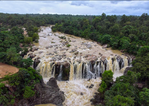



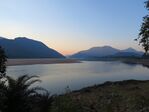
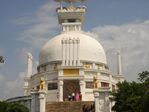


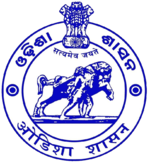



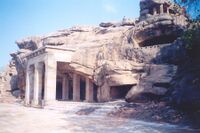

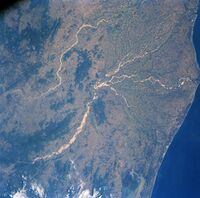
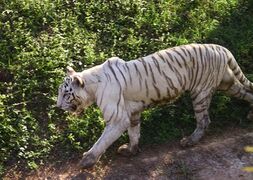
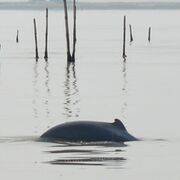
![Vanda tessellata, one of the orchids found in Odisha[58]](/w/images/thumb/6/67/Vanda_tessellata_Orchi_001.jpg/135px-Vanda_tessellata_Orchi_001.jpg)


